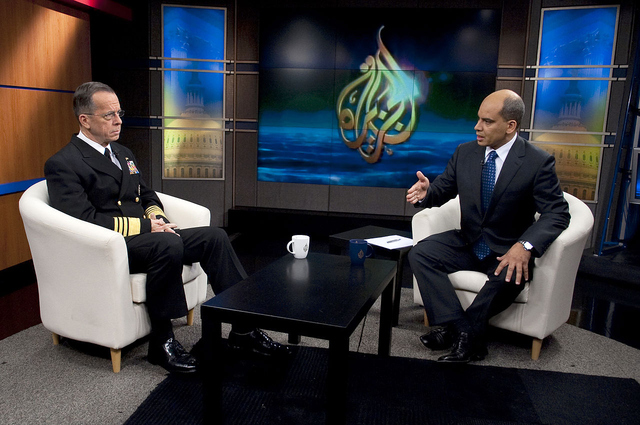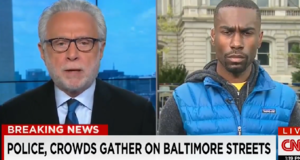From Cornell International Affairs Review VOL. 8 NO. 2Al Jazeera America and Strategic Responses to the "Perception Problem"
KEYWORDS:
On August 20, 2013, Al Jazeera America televised its first official broadcast amidst a frenzy of speculation about the Qatari-backed news channel’s viability in the American media market. Scores of media commentators, ranging from reporters to news executives, praised the fledgling channel’s stated commitment to uninterrupted, hard-hitting, and overlooked news as “something a journalism professor would imagine” 1. Conservative pundits, like Glenn Beck of Fox News fame, immediately meted out blistering condemnations of the channel, going so far – in Beck’s case – as to describe Al Jazeera as “interested in the promotion and protection of Sharia law” and “as close to being an enemy of the state as any media can get” 2. Despite radical right reports to the contrary, Al Jazeera America is not a Muslim media source, nor does it produce any content that suggests it “speaks” for Islam. Since its inception, the channel has largely succeeded in establishing itself as an in-depth and unbiased news network along the lines of the British Broadcasting Corporation (BBC) or CNN. A virtual “firewall,” says Al Jazeera America’s interim CEO Ehab Al Shihabi, ensures the editorial team’s independence from its Qatari patrons 3. However, among the American public the perception persists of a sinister link between Al Jazeera America and radical strains of Islam. This is due to multiple factors: because Al Jazeera America’s parent company (the Al Jazeera Media Network) is headquartered in a Muslim majority country; because the channel is principally bankrolled by Qatar’s royal family; and because the network’s flagship program – Al Jazeera Arabic – came under fire in the early 2000s for appearing to serve as a conduit for Al Qaeda 4. This essay traces the history of the Al Jazeera Media Network up to the birth of Al Jazeera America and discusses the nature of domestic opposition to Al Jazeera America using three distinct yet interrelated analytic perspectives: national security, public discourse, and globalization. The next question it asks follows logically: what tactics has Al Jazeera America used both to shake off the American public’s “perception problem” and to actively appeal to American audiences? This paper compiles the existing literature on the fledgling network and identifies four distinct areas – entry, principles, content, and branding – in which the management of Al Jazeera America has strategically attempted to make the channel appeal to American audiences and assimilate it into American culture. Observing that both Al Jazeera America and American Muslims have been similarly vilified for their perceived connections to radical Islam, the essay concludes its analysis by asking the following question: can we plausibly understand Al Jazeera America’s strategies as representative of the everyday tactics used by thousands of Amer- ican Muslims to win greater recognition and respect from their fellow Americans? Ultimately, it concludes that while both Al Jazeera America and American Muslims are confronted by many shared biases, Al Jazeera America has employed an assimilatory paradigm that most American Muslims would deem unacceptably compromising of their Muslim identity. Thus, while Al Jazeera America’s media relations campaign is an interesting case study of corporate negotiations engaging with public opinion, the network’s strategies are not viable solutions for American Muslims who find themselves rejected and alienated from their socio-political communities. Navy Adm. Mike Mullen, chairman of the Joint Chiefs of Staff, is interviewed by Al Jazeera’s Abderrahim Foukara in Washington, D.C. Photo: Mass Communication Specialist 1st Class Chad J. McNeeley, U.S. Navy. Critics of Al Jazeera may be surprised to learn that the Arab broadcaster’s professional origins are built upon Western foundations. Prior to Al Jazeera’s launch in 1996, Arab citizens had already received a crash course in Western journalism through BBC Arabic Television, a short-lived but highly influential joint venture between a Saudi investment group and the BBC 5. Although the station only lasted two years, it produced a regiment of Western-educated and Western-trained Arab journalists, broadcast administrators and technical staff. They were quickly recruited when the emir of Qatar, Sheikh Hamad bin Khalifa Al Thani, launched Al Jazeera on November 1, 1996, with a $137 million government grant 6. As the network established itself as the first pan-Arab news and public affairs satellite channel broadcasting from the Arab world, its “BBC ethos” lived on. The network committed itself to serving as the lone credible outlet willing to criticize totalitarian regimes and air free and lively debates in a region long dominated by government-owned propaganda machines 7. Indeed, before September 11, 2001, Al Jazeera was a veritable darling of the Western press, hailed as “an unprecedented casting-off of censorship” and an agent of democracy 8. September 11, 2001, was a turning point for Al Jazeera. The network quickly drew harsh criticism from the West for expressing skepticism that Al Qaeda was responsible for the 9/11 terrorist attacks, airing videotapes and images of Al Qaeda and Osama bin Laden, and refusing to frame the American invasion of Afghanistan as a “War on Terror” 9. Pundits and politicians stopped praising the network’s “democratic” coverage and instead turned their wrath on its “fundamentalist” insistence on safeguarding the “social norms and traditions of the region” 10. Other critics pointed scathingly to the television program “Sharia and Life,” hosted by Egyptian Sheikh and Islamic theologian Yousuf Al Qaradawi, as evidence of Al Jazeera’s “ideological affinity with Islamist” organizations like the Muslim Brotherhood 11. In short, Al Jazeera itself became “the story” as American news channels aired President George W. Bush’s accusations of the network’s anti-American sentiment on repeat and criticized its coverage on top-rated talk shows 12. In recent years, the Al Jazeera Media Networkhas recovered some of the esteem it lost in the Western world through the success of Al Jazeera English, its English-language branch. The Emir of Qatar established Al Jazeera English in 2006 because he wanted to “extend the credibility he has established with the Arab network to a broader, international audience,” explains former U.S. marine and Al Jazeera English correspondent John Rushing. The international news channel has quickly proven itself on par with BBC World and CNN International 13. Rather than serving as an English-language translation of Al Jazeera Arabic, Al Jazeera English is a fully staffed and self-directed news channel that features content and vocabulary tailored to its English-speaking audiences around the world 14. Its stated mission is to “give a voice to untold stories, promote debate, and challenge established perceptions,” particularly those regarding the “Global South” 15. Leon Barkho reports that though Al Jazeera’s Qatari patrons “occasionally deploy their power to nip at the network to force it to follow changes in their strategic political alliances,” employees assert they have not been forced to compromise their journalistic integrity. Instead, they boast that “the political order financing the network has steered away from meddling in their editorial decisions” 16. Despite quickly gaining popularity in the United States among the “internationally minded elite class,” Al Jazeera English has been unable to convince U.S. cable companies that Americans won’t dismiss the channel as political propaganda and reach for the remote 17. Weary of relying on web streaming as their primary distribution method in the United States, the Al Jazeera Media Network finally decided to buy its way into the American media market by purchasing Al Gore’s Current TV for $500 million in January 2013. The move effectively allowed the news network to replace the struggling channel with its own programming – Al Jazeera America – in the 48 million homes whose cable providers carried Current TV 18. It is important to understand why the American public might dislike and distrust Al Jazeera America because this analysis provides useful insight into the unique strategies that Al Jazeera America must employ to overcome preexisting biases that other American media outlets do not face. First, the facts: Al Jazeera America faces an uphill battle with American television audiences. Of Americans who do not watch Al Jazeera programming, 75% have a negative impression of it. When Time Warner Cable attempted to drop Current TV from its line-up after the channel was acquired by Al Jazeera, nearly a 2-1 plurality of Americans approved of the media conglomerate’s decision 19. Although no polls shedding light on the specific nature of Americans’ disapproval have been conducted, it would appear that many Americans distrust Al Jazeera America either because they fail to differentiate the channel from Al Jazeera Arabic – which they continue to perceive as the de facto mouthpiece of Al Qaeda and other militant strains of Islam – or because they object to the ownership of the entire Al Jazeera franchise by the Emir of Qatar. These two justifications are often raised in tandem, resulting in a fairly hegemonic – and frequently xenophobic – block of opposition to the fledgling channel. In order to clarify this paper’s analysis and theoretical boundaries, the following sections briefly outline three analytic perspectives that help explain the mass mobilization of antipathy towards Al Jazeera America. The first perspective is national security. Since September 11, 2001, American government officials have played a pivotal role in positing the negative influence of Al Jazeera on United States’ military power overseas. In 2003, for instance, U.S. Deputy Secretary of Defense Paul Wolfowitz accused Al Jazeera of “endangering the lives of American troops,” and in 2004, U.S. Secretary of Defense Donald Rumsfeld claimed that Al Jazeera had “damaged U.S. initiatives in the Middle East” 20. These proclamations, along with more contemporary worries that the Qatari regime boasts “terrorist ties” with clerics who call “for the murder of U.S. soldiers,” has led many Americans to believe that Al Jazeera America – as an “extension” of Al Jazeera Arabic and the purported propaganda arm of Qatar – threatens U.S. national security interests 21. A second and interrelated perspective is public discourse. In addition to airing their criticisms of Al Jazeera’s impact on U.S. defense personnel, American media outlets have also broadcast their own, editorialized stances on Al Jazeera. In doing so, they have contributed to a black-and-white perception of Arab media in the public sphere. Edward Said sums up the current situation perfectly when he concludes “What we have…is a series of crude, essentialized caricatures of the Islamic world presented in such a way as to make that world vulnerable to military aggression” 22. In this context, both Bill O’Reilly’s branding of Al Jazeera as a “terrorist outfit” and Glenn Beck’s assertion that the mission of Al Jazeera is to protect and promote Sharia law reflect a larger trend in modern media: the simplification and sensationalization of news. Because so few Americans – less than 13,000 a day – are watching Al Jazeera America, these second-hand perspectives are particularly powerful and, in Al Jazeera America’s case, destructive 23. The third and final analytic perspective is globalization. One of the primary scholarly reflections on the Al Jazeera media empire is that, as a transnational news network, Al Jazeera has challenged the global North’s long-standing cultural dominance in news flows, contributing to a “gradual deterritorialization” of the public sphere 24. This paper proposes that one interpretation of Americans’ distrust of Al Jazeera America is that Americans have come to see the news channel as an agent of globalization and, thus, an existential threat to their identity and culture 25. The seemingly innocuous question that journalist Diana West uses to begin her column, “What does Al-Jazeera have to do with America?” can thus be interpreted as troubling evidence of what cultural theorist Stuart Hall calls “a regression to a very defensive and highly dangerous form of national identity” 26 Using these perspectives as an abstract frameworkfollowing section turns to a description of the tactics used by Al Jazeera America to seek to win over its seemingly implacable American audience. These tactics can be divided into four strategic areas: entry, principles, content, and branding. Due to preexisting prejudices against the news network, Al Jazeera was forced to “break into” the American media by purchasing rather than “earning” entry in the cable television market. Soon after launching Al Jazeera English, international media directors at the Al Jazeera Media Network began looking towards the United States as a potential market. Attempts to court the country’s largest media providers – Comcast, AT&T, and Time Warner Cable amongst them – proved unsuccessful because media executives were unwilling to believe Americans wouldn’t click past what many regarded as a “terror network” 27. At the end of 2012, only two cities – Toledo, OH and Burlington, VT – offered Al Jazeera English via cable television 28. So Al Jazeera changed tactics; in January 2013, the network announced its purchase of Current TV, a floundering news channel co-founded by former Vice President Al Gore, for $500 million. The purchase would effectively allow Al Jazeera to replace the content on Current TV with its own programming,a new channel it named “Al Jazeera America,” thus circumventing the protests of cable providers that were bound by contract to continue distributing Current TV to the roughly 48 million homes already subscribed to the channel. When AT&T and Time Warner Cable announced their intention to drop the new channel, citing “breaches of contract,” Al Jazeera America responded by threatening to sue the cable providers. The media conglomerates and Al Jazeera have since resolved their differences, and the news network is now available in 55 million American homes 29. In order to win American hearts and minds, it was first necessary for Al Jazeera America to get a foot in the door. The strategic maneuvers necessary to achieve this objective speak to the seriousness of the political obstacles hindering the channel’s expansion in the United States. Immediately after announcing their purchase of Current TV, Al Jazeera went to work, strategically highlighting how the network’s impeccable journalistic principles would distinguish it from its American competitors and render it a beacon to other U.S. news outlets. In an ironic twist, the Qatari-based network has described itself as a revival of serious objective journalism grounded in fact and expertise, rather than in sensationalism and punditry. Turning the Western news media’s assumption of the network’s ideological radicalism on its head, Al Jazeera America has made it their mission to, in essence, beat U.S. news outlets at their own game. “Al Jazeera is coming to America to supply old-fashioned, boots-on-the-ground coverage to a country that doesn’t have enough of it,” Al Jazeera America CEO Ehab Al Shihabi has proclaimed, pledging “there will be less opinion, less yelling and fewer celebrity sightings” 30. Media gurus have, accordingly, rewarded Al Jazeera America with high praise. Leading up to the channel’s launch in the summer of 2013, journalists peppered the network with compliments. Headlines on front pages across the nation read: “Al Jazeera America promises a more sober look at the news,” “Welcome, Al Jazeera America,” and “Al Jazeera aspires higher than cable competitors” 31. Excited about the prospect of a news channel actually putting its principles into practice, political and media elites – like Chicago mayor Rahm Emanuel and Michigan senator Carl Levin – rushed to bestow their seal of approval on the rookie network 32. Al Jazeera America’s most successful “ingratiation strategy” to date thus appears to be its public insistence that it will maintain higher standards of journalistic integrity and expertise than its homegrown American counterparts. In the meantime, Al Jazeera America has also comprehensively retooled its content and staff to suit its domestic audience. Initially, Al Jazeera America executives stated that the channel would be international in scope, with 60% of its news programming coming from the United States and the remaining 40% coming from Al Jazeera English 33. A few months before the channel’s launch, however, network executives announced that they had scrapped their previous plan, and now intended for virtually all of the channel’s programming to come from within the United States 34. Additionally, in the months leading up to Al Jazeera America’s first broadcast, the network chose to hire veteran American staffers from well-known U.S. news outlets like CNN, CBS, and ABC. Their intent, explained Al Jazeera executive producer Bob Wheelock, was to ensure the network could “broadcast stories about Americans by Americans” 35Continued on Next Page » Suggested Reading from Inquiries Journal
Inquiries Journal provides undergraduate and graduate students around the world a platform for the wide dissemination of academic work over a range of core disciplines. Representing the work of students from hundreds of institutions around the globe, Inquiries Journal's large database of academic articles is completely free. Learn more | Blog | Submit Latest in Business & Communications |




















